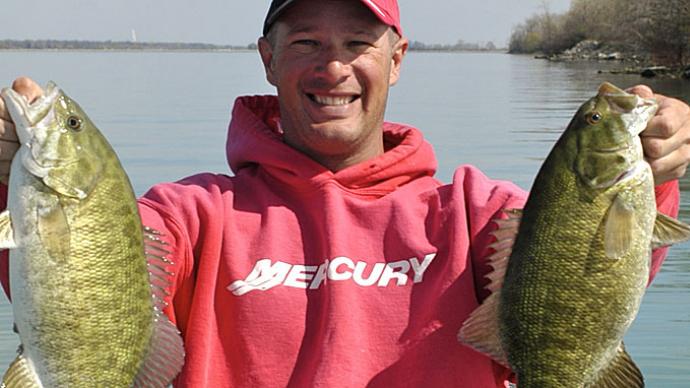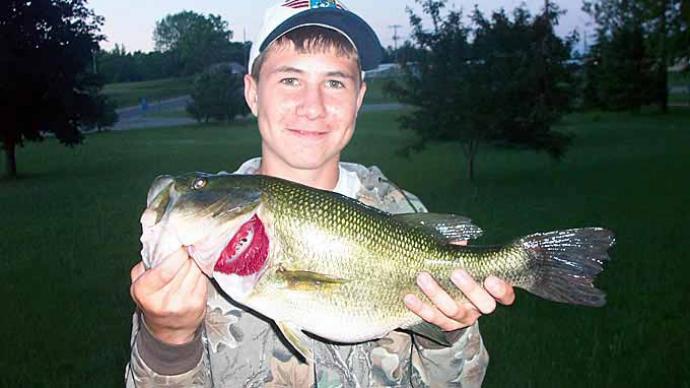
Often times we lose focus. We think color, we think size profile, and we keep thinking like a bass, of which we are not. We always need to remain the hunter, not the hunted. Do not think like the prey, we need to remain the hunter of both the bass and its prey, but to think like neither.
We need to think like a human and focus on where the bass should be, or where we can make one commit to a lure presented properly. This is the key to consistent catches, to make a fish commit regardless if you have a motor oil or pumpkinseed colored soft plastic, or a blue back, or brown back crankbait. Always remain the hunter. Bass do not think as we do and if we try too hard in relating ourselves to them, then we lose focus. I don’t want to say that color is not important, because it is. However you should not bring in color until you have the rest of the equation figured out, and then use it to fine-tune what you are doing.
Locating structure is the most important facet and only humans can visualize it. Bass simply relate to it. If you know how to read structure, perfect. If not, study up and don’t think about color, size, scent, or anything else until you fully understand structure fishing. Without this simple and truly basic knowledge, you may find yourself on a pattern without even knowing it. As an inside tip, it still happens to the best of us even if we think we have an advanced degree in structure fishing. We all chase cover too often knowing that the proper structure is not there to hold either large fish, or a collection of good fish, but nonetheless, maybe this is the day a big fish is under that lay-down. When I approach structure, I do not ever intend on catching just one fish. I am not just talking about local honey holes; I am talking about all structure, and the patterns I can relate to that particular type. Some lakes truly do not offer much in the way of structure, however, this is when even a one-foot change can help put a pattern together.
As a human, we know where they should be on structure based on season, prey availability even oxygen variables. We can also read cover or cues above water to help the decision-making process to narrow down where to fish. A steep bank may look the same for three hundred yards but you can see above water that there is a rockslide along a section. The focus should be there. Same with an old road bed jutting out of the woods onto a point, or a simple shade line you know to be right along an eight-foot contour change. These are easy-to-read cues that we can see, imagine, and most importantly impart logic onto. Again, a bass will simply relate to it. We can use human logic to find bass, but must not convey that same uniquely human logic to what a bass will do. It will simply relate to that feature underwater.
Underwater structure such as channel turns or ridges is easy to find on a map or using electronics. I am a firm believer that if you present a bait in the right spot at the right time, you will get bit. While fishing structure is not anything new, my days on the lake still tell me that most are not doing what they need to do to for consistent catches. Many may have planned the night before on what they are going to do on different structure only to get to the body of water and worry about everything else, forgetting what they should be doing. Often times they will again question their choice of color or even the brand of bait they are throwing.
During the post-spawn time, many fish can still be caught in relatively shallow water, however, unless you are on a great fishery or have a limited pressured lake, then chances are those same fish are being cast to by many. The better fisherman will catch these fish and it comes down to the fact that they have the right combination of timing, and bait presentation. I find it much easier to fish for the deeper fish that many don’t even look for. I feel most comfortable fishing what looks like the middle of nowhere, however knowing that I am fishing a ridge that runs near a channel. If it runs near the mouth of a cove or creek arm, then I like it even better. The shad should use this as a route for their daily migration. Bass should be sitting on this nearly year-round (spawn time presents its own variables, however, all fish do not spawn at the same time). This is what it takes to always be the hunter. You cannot just hope that the fish are going to be there, you have to know they should be there. You would not put up a deer stand where deer will not travel by and I will not position my boat where fish will not travel. Plans always sound good on paper and don’t always pan out, and this is when experienced fishermen will start to break down what they are doing. By changing up the size, type, color, and techniques they can present to catch fish they can narrow down what the best bite will be that day. You must know and believe however that you are on fish.
This is why I like what I consider high percentage baits, or as I like to think of it, “multiple offering baits.” During the post-spawn through mid-summer phase, I throw exactly what I threw during all other times of the year. What makes the difference is why I am throwing this particular bait. My favorite choice for not only numbers but also big fish is a quarter-ounce mop jig. I prefer the Buckeye Lures Mop Jig due to the circumference of the rubber used in the skirting, along with the double rattles. Typically I start with a four-inch trailer and reduce or even increase in size based on the action I am receiving. The best results have been with the Berkely Chigger Craw, however, others could be used as well.
The reason for the mop jig is actually threefold. One, your typical craw representation can be obtained by crawling it up and down cover on your particular structure. Two in movement you can swim it and represent a good eating-sized bream unlucky enough to be seen too far from cover. The third reason is unique to this time period. When working like you would a large tube such as a Gambler Flippin Tube, I believe it also can represent the newly hatched schools of fish. You often times see these schools and can note the dark coloration. The large rubber used in the “mop” is black in coloration and when at rest flares out. In a series of wrist snaps, however, it moves and undulates as a small pod of new hatchlings. It is my belief that even if this would appear out of the norm to see them deep, away from weeds and other such cover, it nonetheless triggers a feeding response. The takeaway is if you present a bait properly, you will get bit. Color is important here, but if you are not where the fish are either by depth or structure type, then color matters none. Some may also question working this bait in deep water at such a low weight of one-fourth ounce. It is much like fishing a stick bait at times, in such that you must be patient enough to let the bait get to the bottom. I especially like to make a long cast into shallower water, and let it slowly slide off the ledges. This slow fall is critical to getting the extra bite. While I will up the weight in water over fifteen feet, this is only to maintain additional contact with the jig. I also will up the weight if I am crawling it from deep to shallow, and am in less need of it to fall slowly off the drop-offs.
This is a bait you do not use to find structure, it is a bait you present to structure you already have mapped in your head, you already know the routes fish should be taking, or where they should be staging. Due to this bait looking like a small school of newly hatched young, it can also be used by making pops with your rod tip at the edges of weed beds. I personally throw it outside edge and parallel to them to cover a bit of water if need be. Ambushing bass need only a glance. I do not use the typical jig gear used to throw three-quarter-ounce jigs or larger ones. I prefer a seven-foot medium-heavy rod that can only throw baits up to half an ounce. I also tame the line down to twelve-pound fluorocarbon as the lighter wire hook penetrates better than standard jigs.
Ideas like the above use of a jig keep us in a predatory frame of mind and keep the fish in our crosshairs. We set the trap based on known routes, using common techniques. These techniques must be used with purpose, however, and not just blindly throwing a jig, but knowing what you want your jig to do, and where these fish should be. If not, you will start to ask questions that will only be answered by being on fish, and you may find yourself out on the water, focus left at the boat ramp.




